Authors:
Holly McQuillan, Elvin Karana
Whether relating to aesthetics, cost, ease of production, the scale of the material, or the body and the time frame contained in interaction design, conventional design's critical zone [1] has been stubbornly human centered. While our desire for technological novelty has been challenged and the adoption of dynamic notions of material, time, and scale encouraged in HCI design, a gap between practices and theories of sustainability persists. Since all physical outcomes embody our engagement with these ideas and their application, if we can't expand HCI's critical zone and do sustainability when designing, prototyping, and materializing, the gap will persist. In truth, design and HCI's critical zone already encompass ecological time and scale; it is just often easier to pretend that they don't. How can we ensure our work celebrates materiality, innovation, and creativity, while nurturing and respecting wider systems that support us all? In response, we introduce multimorphic material thinking as a strong concept grounded in materiality that frames temporality across design, use, and ecological scales. We discuss the broader implications of this approach in the context of HCI textiles and textile-forms.
→ HCI's critical zone already includes ecological concerns, but designers are often tempted to disregard them.
→ Methods for "doing sustainability" when designing and prototyping are necessary to practice within ecological boundaries.
→ Grounded in materiality and innovation, multimorphic material thinking is a strong concept that frames temporality across design, use, and ecological scales.
 What Do We Mean by Multimorphic?
What Do We Mean by Multimorphic?
First introduced in 2020, the concept of multimorphism warrants further articulation in the context of HCI. While multi is perhaps easily understood as a term that suggests plurality and multiplicity, morphic carries some baggage within the HCI context, where morph is commonly used as a synonym for "shape change." When applied as a suffix in multimorphic, however, we build beyond this to a broader definition of morphic as one with both pragmatic and abstract interpretations encompassing aesthetic expression, function, purpose, and wider human and nonhuman systems. All our material and socially constructed systems are currently situated within Earth's biosphere. To act responsibly our critical zone must extend to ecological time and scale. Together with the plurality and multiplicity that multi connotes, we built our definition of multimorphic as a holistic understanding of material systems that explore temporality across design, fabrication, use, and societal and ecological contexts. The question we ask in this article is: What could multimorphism in the context of material-driven design (MDD) contribute to the sustainable goals of the HCI community?
 Textiles, Temporality, and Sustainability in HCI
Textiles, Temporality, and Sustainability in HCI
In HCI, textiles' problematic industry processes are compounded by using smart and electronic materials that combine disposable technology with conventional material waste. Modularity is proposed to support the extension of technological relevancy by enabling obsolete hardware to be repaired or replaced, while design for disassembly is proposed as a recycling solution. Neither of these approaches, however, address the inherent unsustainability of existing systems. In other words, as many materials are understood and designed separately from the objects they make, the inevitable overproduction and underutilization of resources is not addressed in either conventional context or in HCI. In response to problems of user acceptance in HCI, though, we see a push toward embedded materiality, particularly for materials such as textiles. Material-driven approaches in HCI textiles explore materiality and material tinkering and making. They unveil the potential for tuning material qualities for desired experiences that make them more relevant in our daily lives. This alone, however, does not address the use of existing wasteful form design and construction practices. Moreover, addressing material and form as separate components limits the degree of seamlessness and embeddedness possible for interactive material artifacts and therefore underutilizes the inherently performative and multisituated potential of textiles.
Despite these challenges, the unfolding design space situated between embeddedness, seamlessness, and materialness has great potential for sustainable HCI. Multimorphic textile-forms [2] is an approach for design and HCI to evaluate and develop interactive three-dimensional textile-based objects through the lens of extended life cycles and on-demand, local, and zero-waste production, utilizing a material-driven approach. In short, multimorphic textile-forms advocate for multimorphic material thinking within the context of a specific material—textile.
Next, we provide an overview of the three textile-situated concepts (Figure 1) to underpin the material-agnostic discussion on multimorphic material thinking.
Textile-forms are conformal artifacts that can be woven, knitted, molded, grown, or printed in any number of ways. They are designed for simultaneous textile and form fabrication and experienced by the user as soft, malleable materials with textileness [3]. The motivation for developing methods and technologies that enable textile-forms is driven by sustainability goals to facilitate on-demand, local, and zero-waste production. Textile-forms (Figure 2) provide HCI designers with novel production methods and ways of thinking about the relationship between textile and form. The HCI community has often explored the development of digital tools that support the design of these complex textile-based artifacts. The textile-forms themselves, however, do not address the core concern of HCI—interaction—which provides the same opportunities that temporality provides in the development of textile-forms.
 | Figure 2. From left: Knitted textile-form; woven textile-form; grown textile-form; 3D printed textile-form; molded textile-form. |
Morphic textile-forms. These describe textile-forms that are designed and fabricated with embedded capacity for change (physical, biological, digital), either as part of the design/production time for material manipulation purposes or to facilitate embedded and seamless interactions in use time. Similar to the concept of 4D manufacturing, sustainable morphing matter [4], and animated textiles [5], morphic textile-forms embrace a more than digitally enabled definition of smartness, encompassing physical and biological activation. In HCI, we can see many examples of morphic textile-forms already, often utilizing shape change as a dominate temporal element (Figure 3). Morphic textile-forms expand additive and conformal fabrication approaches of textile-forms to leverage time as a design tool for innovation intra-production, while also enabling open-ended interaction in use time.
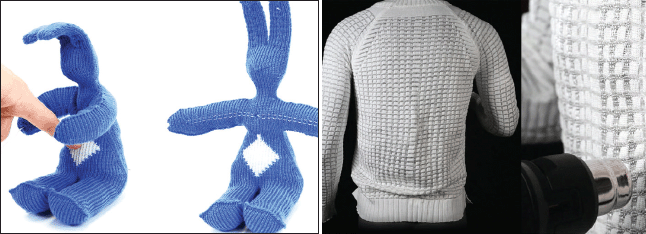 | Figure 3. Examples of morphic and actuated knitted textile-forms: 3D knitted Bunny with integrated animated "tendons" (left); Active Textile Tailoring's heat-activated 3D knitted garments (right). |
Multimorphic textile-forms. While textile-forms enforce a level of holism in their simultaneous design of textile and form and morphic textile-forms expand this holism to include use and/or design and production time, multimorphic textile-forms acknowledge that all material and social practices operate within an ecological context. Their scope and complexity mean there are few examples of textile artifacts that can be considered multimorphic textile-forms. Zero Waste Weaver costumes by Holly McQuillan, Kathryn Walters, and Karin Peterson are made for hyperlocal, automated, and vertical manufacturing facilities from recyclable monomaterial (polyester) with variable heat-reactive fiber/yarn behavior (Figure 4). Conceptually the work adopts a technical nutrient cycle approach: The polyester fiber would be re-mined from the detritus of previous civilizations and can, theoretically at least, be recycled several times in the context of multicycle circularity. The garments' multigenerational life spans are supported by integrated morphic yarn and the use of highly durable polyester fiber. Alternatively, a biological nutrient cycle approach could enable biobased animate materials in textile-forms to facilitate enriched material experiences for regenerative living systems (e.g., the programable knitted textiles by Jane Scott). Multimorphic textile-forms expand the temporal context in HCI to leverage time as a design tool for innovation intra-production, enriching material experiences and facilitating use practices that can span generations and sustain or even regenerate the biosphere.
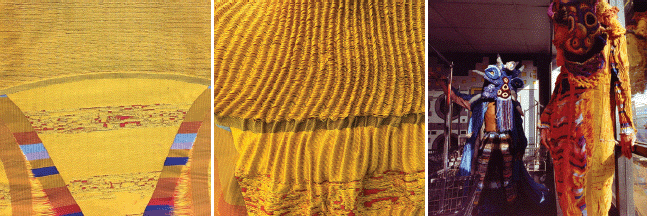 | Figure 4. From left: Untreated woven textile-form; the same section of textile-form after applying heat; Zero Waste Weavers costumes made from polyester monomaterial. |
 Temporality as the Connective Tissue between Materiality and Sustainability
Temporality as the Connective Tissue between Materiality and Sustainability
Multimorphic material thinking (Figure 5) supports the holistic design of artifacts that integrate temporality across matter, structure, form, production, use, and ecosystem relations. It is a bridge between the theoretical roots of established fields in HCI research—MDD and design for sustainability, with an emphasis on temporality as conceptual connective tissue. In this discussion, we articulate how multimorphism can be applied to other material-centric domains and invite designers to develop other techniques to facilitate multimorphic material thinking.
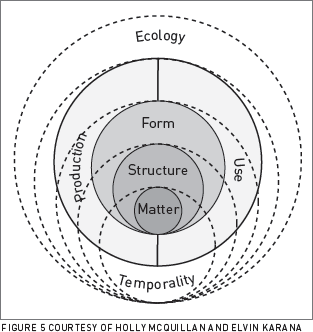 | Figure 5. Multimorphic material thinking. |
 How Simultaneous Design Fabrication Can Unlock the form Potential of Materials for Novel Behaviors and Interactions
How Simultaneous Design Fabrication Can Unlock the form Potential of Materials for Novel Behaviors and Interactions
The simultaneous fabrication of material, structure, and form demonstrated by textile-forms provides many opportunities for HCI, which are already evident in domains such as additive manufacturing (3D printing of metamaterials), ceramics, and biodesign. Most materialized artifacts in HCI, however, are composites of existing materials and components with predefined behaviors, each selected for their contributions to desired functionality and form. Driven by (perceived) necessity and a solutionist view of design, this approach limits the potential for fine-tuning localized behavior. Even in cases where behavior is theoretically tunable across scales through a process (e.g., whole garment knitting or 3D printing), it is common for the process to be—or to be viewed as—somewhat of a black box. While particularly evident in novice or non-designers, even experienced practitioners can have limited understanding of ways to process variables needed to design complex behavior and form from the material. Shape-changing clay dough (Figure 6) demonstrates some of the form potential when norms of materials and processes are transgressed. In addition to the adoption of material-centered perspectives, such as the materials potential framework and MDD, there is a need for accessible education, programming tools, and fabrication equipment. These allow HCI designers to explore the wide array of affordances and variables available for unlocking the form potential of materials and to tune behavior across material scales.
 | Figure 6. Shape-changing clay-dough: taking a material-oriented approach to 3D printing ceramic forms. |
 Animate Materials for Morphic Material-Forms
Animate Materials for Morphic Material-Forms
There are many exciting developments in animate materials, particularly in the material-structure-form space, including 4D printing. Here, the use of animate materials for on-demand and conformal fabrication of HCI products helps tune artifacts specifically to individual users' needs to further enrich their experience or for specific behaviors and functions. In textiles, many examples use heat-reactive yarn as the animate material—these often irreversible animations limit the diversity and longevity of possible interactions. Reframing of traditional materials (e.g., wood or cellulose fibers shown in Figure 7, left) in the context of reversible animate materials and manipulating their properties across scales opens a design space where the inherent temporality of natural materials is leveraged. As new materials are developed or existing ones are reappropriated, alternative means of fabrication can be developed to take advantage of these material properties. For example, in textiles, Hilo's programmable yarn spinning machine and software can enable change in behavior down the length of the yarn, which, in combination with textile-form methods, results in complex behaviors from monomaterial textile-forms. Beyond everyday materials, regenerative living artifacts [6] using materials that are alive and that change and evolve during use time (Figure 7, right) may provide radically different functions and user experiences while also surfacing our connection with diverse ecologies. There are opportunities for further exploration of material forms in a wide array of materials, and, with multimorphic material thinking, HCI designers can lead the development of processes and materials that are innovative, dynamic, and ethical.
 | Figure 7. Animated woven linen (left); living artifacts using iridescent, stimulus-responsive Flavobacteria (right). |
 Building Behavior over Scale for Sustainable HCI
Building Behavior over Scale for Sustainable HCI
Multimorphic material thinking advocates for HCI designers to synergistically build behavior throughout the material system while evaluating and responding to the impacts of material extraction, use, and context. Here, the motivation for tuning a material system across scales is not just for use and interaction—the context of ecological time must be tuned in. For example, ordinarily an HCI designer would evaluate performance for conductivity or robustness of shape change when selecting a material for interactivity, while in MDD a designer would develop and explore a material by tinkering and characterizing its technical and experiential properties to build a vision for potential use. Multimorphic material thinking encourages material-driven designers to explore its temporal qualities across scale and time through a holistic and sustainable lens. Designers should evaluate the context and impact of this material's extraction: Can it be recycled or disassembled, or will it biodegrade? Consider what form it will take and how that form will be constructed—does it reinforce inefficient and exploitative models of fabrication?—and what the ultimate interaction goal is. Are the materials and processes selected in line with the desired experience? What human or more-than-human need is being served? Are the materials and processes selected necessary to achieve this, or is there another innovative approach that means other holistic factors can be attended to? Also consider how long this product will serve its purpose. Can it be upgraded, adapted, or modified, and where will the artifact be in 50 or 500 years? An expanded temporal framing forces designers to confront the reality that all materials and products eventually end up in our shared ecosystem as either food or poison. Designers employing multimorphic material thinking should critically iterate on their ideas with these questions throughout the design process. Analyzing, evaluating, and reflecting on the short- and long-term ecological and social impacts is part of the research conception, design, and prototype development. By exploring temporal qualities throughout the interconnected scales of material systems, the underexplored synergies can be utilized in HCI for generating seamless and embedded interactions while avoiding the perpetuation of existing unsustainable systems. Of course, in many cases, there is no perfect solution due to limitations of situation or availability. However, as Donna Haraway writes, by "staying with the trouble," designers not only gain a deep understanding of the limitations and opportunities of their work but also new avenues for future research and collaboration.
 Challenges and Future Work for HCI Designers
Challenges and Future Work for HCI Designers
To design for change over time, from material to ecosystem, designers require a deep understanding of the interrelationship between each level in the material hierarchy and how processes can be tuned, while maintaining a commitment to utilizing a holistic and non-anthropocentric lens. Ecological time brings a level of complexity to HCI that differs between materials and contexts. In HCI, the use of malleable and relatively unpredictable soft material systems, such as textiles, raises many challenges as they are somewhat imperfect mediators of technology. Applying predictable technology on textile substrates is an easy strategy that ensures the technology works as intended. However, in addition to making end-of-life and circularity problematic, it also diminishes the potential utility and rich interactions that textiles' complexity and malleability provides to HCI designers. To fully utilize the potential of all materials used in HCI we need to be critical of the criteria used to evaluate tangible interfaces while celebrating the properties we chose the materials for in the first instance. A simultaneous commitment to scientific and moral objectives and an openness toward uncertainty as championed by MDD will aid in these endeavors. Furthermore, by developing tools that model change over time and that support the holistic evaluation of design decisions during design, HCI designers can be better in finding the right balance between innovative fabrication processes, novel material application, user experience, and sustainability. For example, a fully automated, zero-waste, and single-step process for growing a living artifact may result in an outcome so far removed from societal expectations that acceptance is hindered. While there is potential in multimorphic material thinking approaches to transform HCI and design, without the necessary skills, applied examples, detailed techniques, and tools, HCI is likely to default to existing processes that perpetuate the status quo.
As leaders in the development of novel everyday technology, HCI designers cannot delegate care for ecology to others to deal with in the future. However, within HCI, a tendency toward human exceptionalism valorizes innovation and scientific progress, existing alongside reluctance to allow for more than user needs to affect the work we do (see the corpus of sustainable discourse in HCI). Putting sustainability at the forefront of HCI is not straightforward. Working with these technically challenging materials and processes from a functional perspective for users is already challenging, and adding sustainability into the design and evaluation process may feel daunting and limiting. Designers can be seduced into believing that using innovative materials is enough, which limits critical reflection of the impact on people, society, and ecology. While MDD helps provide practical tools to bridge technical and experiential qualities of materials for HCI, through the inclusion of ecological time and scale, multimorphic material thinking adds significant technical and design challenges. These are the challenges we want to tackle in our future work. Given the multiple crises facing Earth, designers must be supported to understand materials and processes in ways that reveal and celebrate the interconnections between all entities inhabiting this pale blue dot. We hope that this approach inspires HCI designers to view their own and the work of others in a different light and encourages novel seamless, conformal, sustainable solutions in HCI so that there are many more examples of multimorphic material thinking in the future.
We'd like to thank the following authors who allowed us to use the images from their work in the article: Vidya Narayanan, Lea Albaugh, Jessica Hodgins, Stelian Coros, and James McCann at Carnegie Mellon University; Claire Harvey, Emily Holtzman, Joy Ko, Brooks Hagan, Rudong Wu, Steve Marschner, and David Kessler; Diana Scherer; Jack Forman, Mustafa Doga Dogan, Hamilton Forsythe, and Hiroshi Ishii; Aniela Hoitink at MycoTEX (Figure 2). Lea Albaugh, Scott E. Hudson, and Lining Yao; Lavender Tessmer, Carmel Snow, Sophie Richter, Schendy Kernizan, Jared Laucks, and Skylar Tibbits (Figure 3). Planet City film crew that included Holly McQuillan, Karin Peterson, and Kathryn Walters (costume design), Zac Monday (mask artist), Liam Young (director and production designer), Ane Crabtree (costume director/producer), and Driely S. (still photography) (Figure 4). Fiona Bell, Erin McClure, Camila Friedman-Gerlicz, Ruby Ta, and Leah Buechley (Figure 6). Kathryn Walters, Laura Devendorf, and Karin Landahl; Clarice Risseeuw, Holly McQuillan, Joana Martins, and Elvin Karana (Figure 7).
1. Jensen, O. Rethinking scale—Relationality, place, and critical zone. In Nordes 2021:Matters of Scale. E. Brandt, T. Markussen, E. Berglund, G. Julier, and P. Linde, eds. Nordes, 2021.
2. McQuillan, H. and Karana, E. Conformal, seamless, sustainable: Multimorphic textile-forms as a material-driven design approach for HCI. Proc. of the 2023 CHI Conference on Human Factors in Computing Systems. ACM, 2023, Article 727, 1–19.
3. Gowrishankar, R., Bredies, K., and Ylirisku, S. A strategy for material-specific e-textile interaction design. In Smart Textiles: Fundamentals, Design, and Interactions. S. Schneegass and O. Amft, eds. Springer International Publishing, 2017, 233–257.
4. Patel, D.K., Zhong, K., Xu, H., Islam, M.F., and Yao, L. Sustainable morphing matter: Design and engineering practices. Advanced Materials Technologies 8, 23 (2023). Article 2300678.
5. Buso, A., McQuillan, H., Jansen, K., and Karana, E. The unfolding of textileness in animated textiles: An exploration of woven textile-forms. DRS Conference Proceedings 2022. Design Research Society, 2022.
6. Karana, E., McQuillan, H., Rognoli, V., and Giaccardi, E. Living artefacts for regenerative ecologies. Research Directions: Biotechnology Design 1 (2023), e16.
Holly McQuillan is an assistant professor in multimorphic textile systems and a cofounder of the Centre of Design Research for Regenerative Material Ecologies at the Delft University of Technology. Her research explores interwoven fiber-yarn-textile-form systems to transform how textile-based forms are designed, manufactured, used, and recovered. Oriented through a holistic lens, her research advocates for a new understanding of the relationship between designer and system, material and form, to conceptualize and prototype alternative futures. [email protected]
Elvin Karana is a professor of materials in novation and design and a cofounder of the Materials Experience Lab and the Centre of Design Research for Regenerative Material Ecologies at the Delft University of Technology, which explores the potential of material-driven design for planetary well-being. Her research focuses on the intersection of design, biotechnology, and materials science, exploring innovative biomaterials that integrate seamlessly into everyday life while aligning with the diverse temporalities and scales of ecosystems. [email protected]
 This work is licensed under Creative Commons Attribution International 4.0.
This work is licensed under Creative Commons Attribution International 4.0.
The Digital Library is published by the Association for Computing Machinery. Copyright © 2025 ACM, Inc.
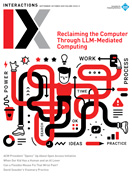

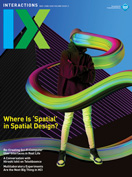
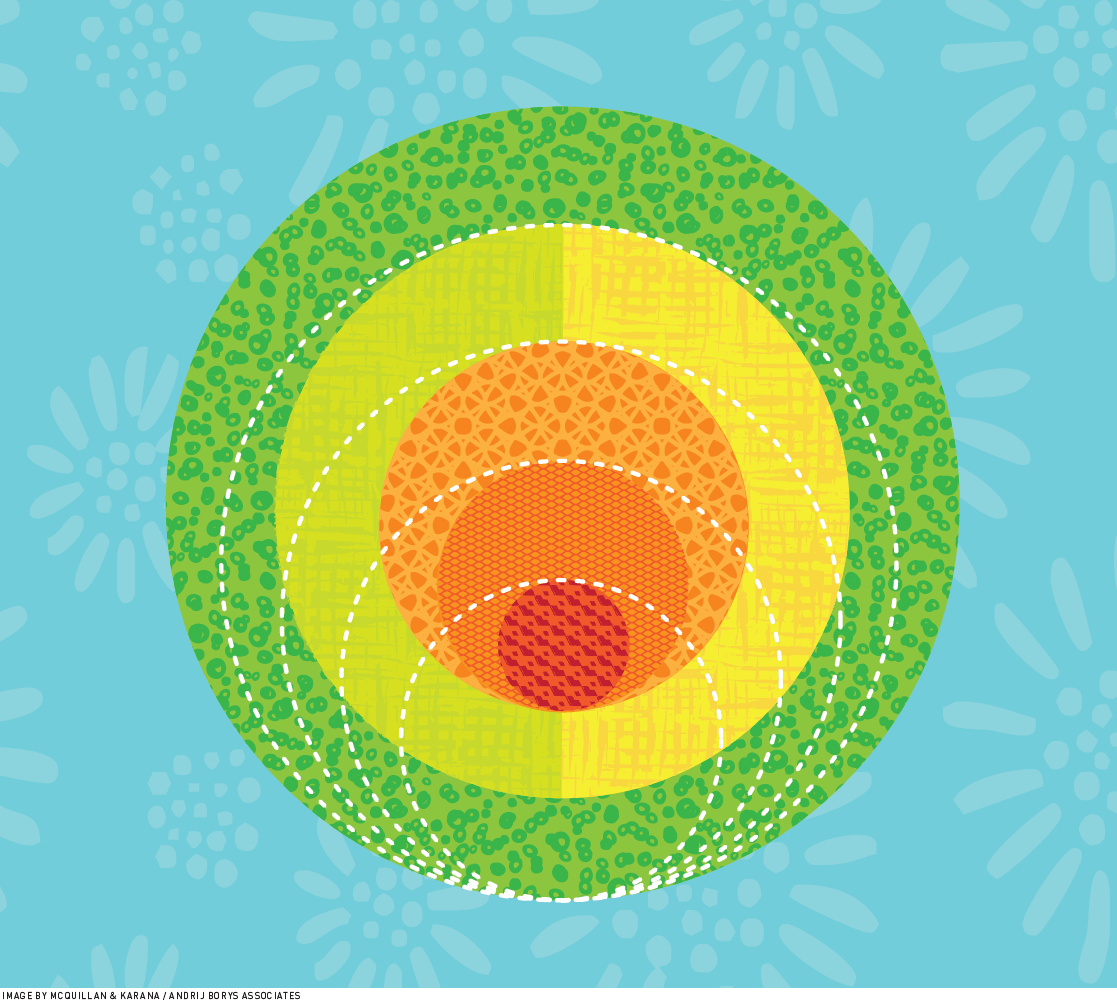




Post Comment
No Comments Found